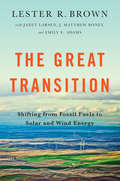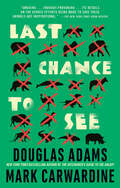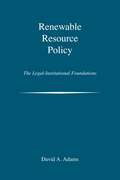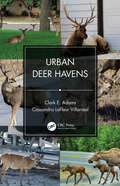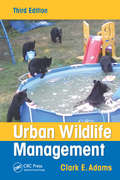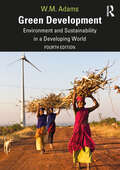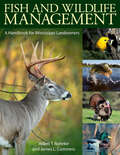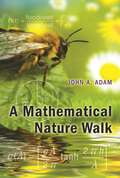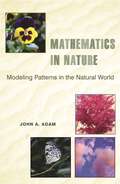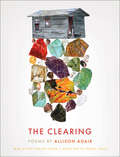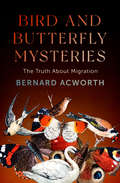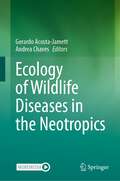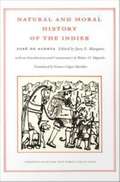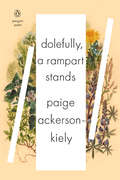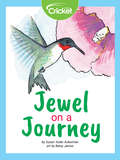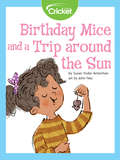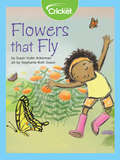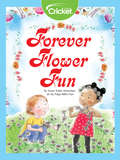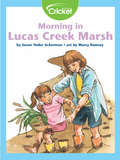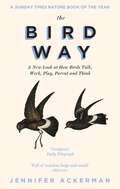- Table View
- List View
Treasure from the Sea (Fountas & Pinnell LLI Red #Level J)
by Jacqueline AdamsAround the world, people hunt for a treasure called sea glass. This treasure used to be trash!
Underwater Art (Fountas & Pinnell Classroom, Guided Reading Grade 4)
by Jacqueline AdamsART TO THE RESCUE One of the largest coral reef systems in the world was in danger of being damaged beyond repair. The solution? A unique museum, dreamed up by an environmentalist, a businessman, and an artist, all working together. NIMAC-sourced textbook
A Walk in the Woods (Fountas & Pinnell Classroom, Guided Reading)
by Jacqueline AdamsNIMAC-sourced textbook
Wanted: Lost Amphibians (Fountas & Pinnell LLI Purple #Level T)
by Jacqueline AdamsMany of the world's frogs went missing. Some hadn't been seen in more than a hundred years. Were they gone forever? Scientists went a worldwide hunt to find out.
The Great Transition: Shifting from Fossil Fuels to Solar and Wind Energy
by Emily Adams Janet Larsen Lester R. Brown J Matthew RoneyThe great energy transition from fossil fuels to renewable sources of energy is under way. As oil insecurity deepens, the extraction risks of fossil fuels rise, and concerns about climate instability cast a shadow over the future of coal, a new world energy economy is emerging. The old economy, fueled by oil, natural gas, and coal is being replaced with one powered by wind, solar, and geothermal energy. The Great Transition details the accelerating pace of this global energy revolution. As many countries become less enamored with coal and nuclear power, they are embracing an array of clean, renewable energies. Whereas solar energy projects were once small-scale, largely designed for residential use, energy investors are now building utility-scale solar projects. Strides are being made: some of the huge wind farm complexes under construction in China will each produce as much electricity as several nuclear power plants, and an electrified transport system supplemented by the use of bicycles could reshape the way we think about mobility.
Last Chance to See
by Douglas Adams Mark Carwardine"Very funny and moving...The glimpses of rare fauna seem to have enlarged [Adams'] thinking, enlivened his world; and so might the animals do for us all, if we were to help them live."THE WASHINGTON POST BOOK WORLDJoin bestselling author Douglas Adams and zooligist Mark Carwardine as they take off around the world in search of exotic, endangered creatures. Hilarious and poignant--as only Douglas Adams can be--LAST CHANCE TO SEE is an entertaining and arresting odyssey through the Earth's magnificent wildlife galaxy.From the Trade Paperback edition.
Renewable Resource Policy: The Legal-Institutional Foundations
by David A. AdamsRenewable Resource Policy is a comprehensive volume covering the history, laws, and important national policies that affect renewable resource management. The author traces the history of renewable natural resource policy and management in the United States, describes the major federal agencies and their functions, and examines the evolution of the primary resource policy areas. The book provides valuable insight into the often neglected legal, administrative, and bureaucratic aspect of natural resource management. It is a definitive and essential source of information covering all facets of renewable resource policy that brings together a remarkable range of information in a coherent, integrated form.
Urban Deer Havens
by Clark E. Adams Cassandra LaFleur VillarrealUrban Deer Havens consists of a thorough examination of selected cervid (deer) species that are known to inhabit urban communities in the United States. The deer species that are included in this presentation consisted of white-tailed (Odocoileus virginianus), Key deer (O. v. clavium), moose (Alces alces), elk (Cervus elaphus), mule (Odocoileus hemionus), and black-tailed deer (O. h. columbianus). This book is the first attempt to examine the similarities and differences in those factors that allow the selected cervids to exist and thrive in urban habitats. This information has never been collected, collated, reviewed, and published under one cover document. Yet, all five are known to inhabit urban communities within their geographic range. The lack of information concerning several important examples of urban cervids in conjunction with a proliferation of information on white-tailed deer only is an incomplete and biased presentation. This book is the first comprehensive source of information on urban deer management, which includes a broad assemblage of urban cervids. The overall objective of this book is to provide a more holistic examination of urban cervids. For example, it examines the similarities and differences of the environmental impacts, management strategies, and human dimensions considerations concerning urban cervids in general, and using specific examples. Urban Deer Havens features four chapters that include: Urban deer census techniques and population dynamics Comprehensive tables that review urban community deer management plans National and state-wide estimates the five selected cervids Laws and regulations concerning urban deer Lethal and nonlethal management options for managing deer Steps for managing urban deer populations Examples of urban deer management efforts
Urban Wildlife Management
by Clark E. AdamsWinner of the 2018 TWS Wildlife Publication Awards in the authored book category Urban development is one of the leading worldwide threats to conserving biodiversity. In the near future, wildlife management in urban landscapes will be a prominent issue for wildlife professionals. This new edition of Urban Wildlife Management continues the work of its predecessors by providing a comprehensive examination of the issues that increase the need for urban wildlife management, exploring the changing dynamics of the field while giving historical perspectives and looking at current trends and future directions. The book examines a range of topics on human interactions with wildlife in urbanized environments. It focuses not only on ecological matters but also on political, economic, and societal issues that must be addressed for successful management planning. This edition features an entirely new section on urban wildlife species, including chapters on urban communities, herpetofauna, birds, ungulates, mammals, carnivores, and feral and introduced species. The third edition features Five new chapters 12 updated chapters Four new case studies Seven new appendices and species profiles 90 new figures A comprehensive analysis of terrestrial vertebrate locations by state and urban observations Each chapter opens with a set of key concepts which are then examined in the following discussions. Suggested learning experiences to enhance knowledge conclude each chapter. The species profiles cover not only data about the animal concerned but also detail significant current management issues related to the species. An updated and expanded teaching tool, Urban Wildlife Management, Third Edition identifies the challenges and opportunities facing wildlife in urban communities as well as factors that promote or threaten their presence. It gives both students and professionals a solid grounding in the required fundamental ecological principles for understanding the effects of human-made environments on wildlife.
Green Development: Environment and Sustainability in a Developing World
by Bill AdamsThe concept of sustainability lies at the core of the challenge of environment and development, and the way governments, business and environmental groups respond to it. Green Development provides a clear and coherent analysis of sustainable development in both theory and practice. Green Development explores the origins and evolution of mainstream thinking about sustainable development and offers a critique of the ideas behind them. It draws a link between theory and practice by discussing the nature of the environmental degradation and the impacts of development. It argues that, ultimately, ‘green’ development has to be about political economy, about the distribution of power, and not about environmental quality. Its focus is strongly on the developing world. The fourth edition retains the broad structure of previous editions, but has been updated to reflect advances in ideas and changes in international policy. Greater attention has been given to the political ecology of development, and market-based and neoliberal environmentalism, and degrowth. This fully revised edition discusses: the origins of thinking about sustainability and sustainable development, and its evolution to the present day. the ideas that dominate mainstream sustainable development (including natural capital, the green economy, market environmentalism and ecological modernization). critiques of mainstream ideas and of neoliberal framings of sustainability, and alternative ideas about sustainability that challenge ‘business as usual’ thinking, such as arguments about limits to growth, and calls for degrowth. the dilemmas of sustainability in the context forests, desertification, food and faming, biodiversity conservation and dam construction. the challenge of policy choices about sustainability, particularly between reformist and radical responses to the contemporary global dilemmas. Green Development offers clear insights into the challenges of environmental sustain- ability, and social and economic development. It is unique in offering a synthesis of theoretical ideas on sustainability and in its coverage of the extensive literature on environment and development around the world. The book has proved its value to generations of students as an authoritative, thought-provoking and readable guide to the field of sustainable development.
Fish and Wildlife Management: A Handbook for Mississippi Landowners
by Adam T. Rohnke and James L. CumminsFeaturing over five hundred illustrations and forty tables, this book is a collection of in-depth discussions by a tremendous range of experts on topics related to wildlife and fisheries management in Mississippi. Beginning with foundational chapters on natural resource history and conservation planning, the authors discuss the delicate balance between profit and land stewardship. A series of chapters about the various habitat types and the associated fish and wildlife populations that dominate them follow. Several chapters expand on the natural history and specific management techniques of popular species of wildlife, including white-tailed deer, eastern wild turkey, and other species. Experts discuss such special management topics as supplemental, wildlife-food planting, farm pond management, backyard habitat, nuisance animal control, and invasive plant species control. Leading professionals who work every day in Mississippi with landowners on wildlife and fisheries management created this indispensable book. The up-to-date and applicable management techniques discussed here can be employed by private landowners throughout the state. For those who do not own rural lands but have an interest in wildlife and natural resources, this book also has much to offer. Residents of urban communities interested in creating a wildlife-friendly yard will delight in the backyard habitat chapter specifically written for them. Whether responsible for one-fourth of an acre or two thousand, landowners will find this handbook to be an incalculable aid on their journey to good stewardship of their Mississippi lands.
Austral Ark
by Adam Stow Norman Maclean Gregory I. Holwell Adam Stow Norman MacleanAustralia and New Zealand are home to a remarkable and unique assemblage of flora and fauna. Sadly though, by virtue of their long isolation, and a naïve and vulnerable biota, both countries have suffered substantial losses to biodiversity since European contact. Bringing together the contributions of leading conservation biologists, Austral Ark presents the special features and historical context of Austral biota, and explains what is being conserved and why. The threatening processes occurring worldwide are discussed, along with the unique conservation problems faced at regional level. At the same time, the book highlights many examples of conservation success resulting from the innovative solutions that have been developed to safeguard native species and habitats in both New Zealand and Australia. Austral Ark fills an important gap regarding wildlife gains and declines, and how best to take conservation forward to keep this extraordinary area of the world thriving.
A Mathematical Nature Walk
by John AdamHow heavy is that cloud? Why can you see farther in rain than in fog? Why are the droplets on that spider web spaced apart so evenly? If you have ever asked questions like these while outdoors, and wondered how you might figure out the answers, this is a book for you. An entertaining and informative collection of fascinating puzzles from the natural world around us, A Mathematical Nature Walk will delight anyone who loves nature or math or both. John Adam presents ninety-six questions about many common natural phenomena--and a few uncommon ones--and then shows how to answer them using mostly basic mathematics. Can you weigh a pumpkin just by carefully looking at it? Why can you see farther in rain than in fog? What causes the variations in the colors of butterfly wings, bird feathers, and oil slicks? And why are large haystacks prone to spontaneous combustion? These are just a few of the questions you'll find inside. Many of the problems are illustrated with photos and drawings, and the book also has answers, a glossary of terms, and a list of some of the patterns found in nature. About a quarter of the questions can be answered with arithmetic, and many of the rest require only precalculus. But regardless of math background, readers will learn from the informal descriptions of the problems and gain a new appreciation of the beauty of nature and the mathematics that lies behind it.
Mathematics in Nature: Modeling Patterns in the Natural World
by John AdamFrom rainbows, river meanders, and shadows to spider webs, honeycombs, and the markings on animal coats, the visible world is full of patterns that can be described mathematically. Examining such readily observable phenomena, this book introduces readers to the beauty of nature as revealed by mathematics and the beauty of mathematics as revealed in nature. Generously illustrated, written in an informal style, and replete with examples from everyday life, Mathematics in Nature is an excellent and undaunting introduction to the ideas and methods of mathematical modeling. It illustrates how mathematics can be used to formulate and solve puzzles observed in nature and to interpret the solutions. In the process, it teaches such topics as the art of estimation and the effects of scale, particularly what happens as things get bigger. Readers will develop an understanding of the symbiosis that exists between basic scientific principles and their mathematical expressions as well as a deeper appreciation for such natural phenomena as cloud formations, halos and glories, tree heights and leaf patterns, butterfly and moth wings, and even puddles and mud cracks. Developed out of a university course, this book makes an ideal supplemental text for courses in applied mathematics and mathematical modeling. It will also appeal to mathematics educators and enthusiasts at all levels, and is designed so that it can be dipped into at leisure.
The Clearing: Poems (Max Ritvo Poetry Prize Ser.)
by Allison AdairA poetry debut that&’s &“a lush, lyrical book about a world where women are meant to carry things to safety and men leave decisively&” (Henri Cole). Luminous and electric from the first line to the last, Allison Adair&’s debut collection navigates the ever-shifting poles of violence and vulnerability with a singular incisiveness and a rich imagination. The women in these poems live in places that have been excavated for gold and precious ores, and they understand the nature of being hollowed out. From the midst of the Civil War to our current era, Adair charts fairy tales that are painfully familiar, never forgetting that violence is often accompanied by tenderness. Here we wonder, &“What if this time instead of crumbs the girl drops / teeth, her own, what else does she have&”?The Clearing knows the dirt beneath our nails, both alone and as a country, and pries it gently loose until we remember something of who we are, &“from before . . . from a similar injury or kiss.&” There is a dark beauty in this work, and Adair is a skilled stenographer of the silences around which we orbit. Described by Henri Cole as &“haunting and dirt caked,&” her unromantic poems of girlhood, nature, and family linger with an uncommon, unsettling resonance.Winner of the 2019 Max Ritvo Poetry PrizePraise for The Clearing &“A dark and bodily nod to folk- and fairy-tale energy.&” —Boston Globe &“The poems in Adair&’s debut draw on folklore and the animal world to assert feminist viewpoints and mortal terror in lush musical lines, as when &“A fat speckled spider sharpens / in the shoe of someone you need.&” —New York Times Book Review, &“New & Noteworthy Poetry&” &“Like Grimms&’ fairy tales, Adair&’s poems are dark without being bleak, hopeless, or disturbing. Readers will find the collections lush language and provocative imagery powerfully resonant.&” —Publishers Weekly (Starred Review)
Bird and Butterfly Mysteries: The Truth About Migration
by Bernard AcworthAs part of his challenge to the theory of evolution, the outspoken creationist presents alternative theories of bird flight and migration. In 1932, Bernard Acworth established the Evolution Protest Movement (now called the Creation Science Movement) for the purpose of criticizing evolutionary theory in scientific terms. A freelance journalist and amateur ornithologist, he took aim at the accepted science of ornithology with a keenly skeptical eye. Here, Acworth addresses topics including bird and butterfly migration, and the peculiarities of the cuckoo. In Bird and Butterfly Mysteries, Acworth presents a close examination of the science concerning the flight of winged animals. Through this analysis, he exposes errors that call into question many of the major conclusions reached by professional ornithologists. While the two Laws of Currents Acworth proposes in this volume have since appeared in other works on ornithology, he has never received due credit for their discovery.
Ecology of Wildlife Diseases in the Neotropics
by Gerardo Acosta-Jamett Andrea ChavesThis contributed volume focuses on the Neotropical region, and explores the environmental, ecological and socio-economic components that facilitate the emergence of zoonotic diseases. This book highlights the primary ecological, environmental, social, and economic variables associated with the risk of maintenance, transmission, and dissemination of emerging, re-emerging, and neglected infectious diseases, in which Neotropical vertebrates are involved. It compiles up-to-date knowledge and research for the neotropical region, as well as discusses the current needs of knowledge improvement. The chapters include various examples of the cycles of infectious diseases, all with world-wide relevance where neotropical wild vertebrates are affected or involved.
Natural and Moral History of the Indies
by José De AcostaThe Natural and Moral History of the Indies, the classic work of New World history originally published by José de Acosta in 1590, is now available in the first new English translation to appear in several hundred years. A Spanish Jesuit, Acosta produced this account by drawing on his own observations as a missionary in Peru and Mexico, as well as from the writings of other missionaries, naturalists, and soldiers who explored the region during the sixteenth century. One of the first comprehensive investigations of the New World, Acosta's study is strikingly broad in scope. He describes the region's natural resources, flora and fauna, and terrain. He also writes in detail about the Amerindians and their religious and political practices. A significant contribution to Renaissance Europe's thinking about the New World, Acosta's Natural and Moral History of the Indies reveals an effort to incorporate new information into a Christian, Renaissance worldview. He attempted to confirm for his European readers that a "new" continent did indeed exist and that human beings could and did live in equatorial climates. A keen observer and prescient thinker, Acosta hypothesized that Latin America's indigenous peoples migrated to the region from Asia, an idea put forth more than a century before Europeans learned of the Bering Strait. Acosta's work established a hierarchical classification of Amerindian peoples and thus contributed to what today is understood as the colonial difference in Renaissance European thinking.
Dolefully, A Rampart Stands (Penguin Poets)
by Paige Ackerson-KielyA collection of haunting, image-rich poems about isolation, captivity, and vanishing.The poems in Paige Ackerson-Kiely's third collection are set primarily in the rural northeast of America, and explore rural poverty, entrapment, captivity, violence, and a longing to vanish. Ranging from free verse to a long noir prose poem, they examine who her, or our, "captors" might be. Ackerson-Kiely is interested in characters who are aware of their foibles, and who find ways to turn away from those problems in search of connection and freedom.
Jewel on a Journey
by Susan Yoder Ackerman Betsy JamesTrey and Susannah hear a loud thump and learn that the fallen tiny bird laying on their deck is a Hummingbird! Miss Nora, their neighbor, cares for birds and may be able to help them save the bird. Discover what Miss Nora does to help the Hummingbird. Will the injured bird fly again?
Birthday Mice and a Trip Around the Sun
by Susan Yoder AckermanA girl named Nina celebrates her birthday with her family and enjoys eating chocolate mice—her favorite treat! When she wants more, her mother says that she must wait a year. Eager with anticipation, she celebrates other holidays and enjoys the seasons. By her sixth birthday, she can't wait to enjoy the chocolate mouse treats again!
Flowers that Fly
by Susan Yoder AckermanSimon teaches his little cousin Adeline about how to grow a garden that will attract beautiful butterflies.
Forever Flower Fun
by Susan Yoder AckermanThere are so many fun things to do outside during the summer! When the flowers bloom, there is flower fun for everyone! When their hollyhock ladies and daisy chains wilt, Lily Rose and her friend learn how to preserve flowers by drying them. There's always an adventure in nature!
Morning in Lucas Creek Marsh
by Susan Yoder AckermanThomas, Madeline, and their mother go on a walk through a Virginia tidewater marsh, spotting all kinds of wildlife along the way.
The Bird Way: A New Look at How Birds Talk, Work, Play, Parent, and Think
by Jennifer Ackerman'A celebration of the dizzying variety of bird life and behaviour, one that will enthral birders and non-birders alike' The ObserverFrom the New York Times bestselling author of The Genius of Birds, a radical investigation into the bird way of being, and the recent scientific research that is dramatically shifting our understanding of birds. 'There is the mammal way and there is the bird way.' This is one scientist's pithy distinction between mammal brains and bird brains: two ways to make a highly intelligent mind. But lately, scientists have taken a new look at bird behaviours they've previously dismissed as anomalies. What they're finding is upending the traditional view of how birds live, how they communicate, forage, court, survive. They're also revealing the remarkable intelligence underlying these activities, abilities we once considered uniquely our own - deception, manipulation, kidnapping, infanticide, but also, ingenious communication between species, collaboration, altruism and play. Some of these behaviours are biological conundrums that seem to push the edges of - well - birdness: A mother bird that kills her own infant sons, and another that selflessly tends to the young of other birds. Young birds that devote themselves to feeding their siblings and others so competitive they'll stab their nestmates to death. Birds that give gifts and birds that steal, birds that dance or drum, that paint their creations or paint themselves, and birds that summon playmates with a special call - and may hold the secret to our own penchant for playfulness and the evolution of laughter. Drawing on personal observations, the latest science, and her bird-related travel around the world, Ackerman shows there is clearly no single bird way of being. In every respect, in plumage, form, song, flight, lifestyle, niche, and behaviour, birds vary. It's what we love about them.'Biologist and bestselling author Jennifer Ackerman knows what she's talking about . . . Chapter by meatily evidence-based chapter, she lays out the assumptions that underpin our understanding of birds - and then pecks them apart . . . Her knack for catching the personalities of different species in gorgeous, playful prose further collapses comfortable barriers between the human and the birdlike . . . More than it is a book about birds - and it is, indisputably, a book about birds - The Bird Way is about diversity and tolerance. A little bird told me that's just what we need in 2020' Daily Telegraph, ***** (Five Stars)'Jennifer Ackerman is not a field researcher, but with her eye for a great story she converts the scientific findings of others into popular books. The real joy of her book is its close attention to some of the specialists of the region . . . Ackerman is also alive to the humour at play in field research' Mark Cocker, The Spectator

